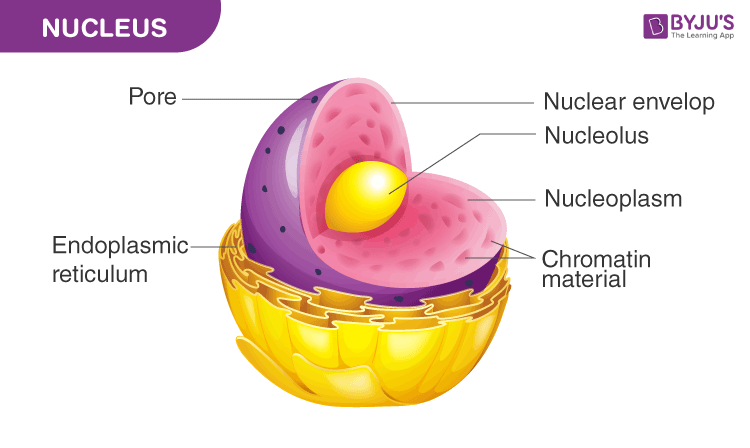
Table of Contents

What is a Nucleus?
The most integral component of the cell is the nucleus (plural: nuclei). It is derived from a Latin word which means “kernel of a nut”.
Nucleus Definition:
A nucleus is defined as a double-membraned eukaryotic cell organelle that contains the genetic material.

A nucleus diagram highlighting the various components. Moreover, only eukaryotes have the nucleus, prokaryotes have the nucleoid
As stated above, the nucleus is found only in eukaryotes and is the defining characteristic feature of eukaryotic cells. However, some cells, such as RBCs do not possess a nucleus, though they originate from a eukaryotic organisms.
More to Explore: Difference Between Nucleus and Nucleoid
Structure Of Nucleus
- Typically, it is the most evident organelle in the cell.
- The nucleus is completely bound by membranes.
- It is engirdled by a structure referred to as the nuclear envelope.
- The membrane distinguishes the cytoplasm from the contents of the nucleus
- The cell’s chromosomes are also confined within it.
- DNA is present in the Chromosomes, and they provide the genetic information required for the creation of different cell components in addition to the reproduction of life.
Also Read: Nucleolus
Nucleus Function
Following are the important nucleus function:
- It contains the cell’s hereditary information and controls the cell’s growth and reproduction.
- The nucleus has been clearly explained as a membrane-bound structure that comprises the genetic material of a cell.
- It is not just a storage compartment for DNA, but also happens to be the home of some important cellular processes.
- First and foremost, it is possible to duplicate one’s DNA in the nucleus. This process has been named DNA Replication and produces an identical copy of the DNA.
- Producing two identical copies of the body or host is the first step in cell division, where every new cell will get its own set of instructions.
- Secondly, the nucleus is the site of transcription. Transcription creates different types of RNA from DNA. Transcription would be a lot like creating copies of individual pages of the human body’s instructions which may be moved out and read by the rest of the cell.
- The central rule of biology states that DNA is copied into RNA, and then proteins.
Also Read: Nuclear membrane
Discover more about the Nucleus, its features and functions, or any other related topics by registering at BYJU’S Biology.
Further Reading:
Frequently Asked Questions
What is the nucleus?
The nucleus is a double-membraned organelle that contains the genetic material and other instructions required for cellular processes. It is exclusively found in eukaryotic cells and is also one of the largest organelles.
Outline the structure of the Nucleus.
- A double-membraned organelle known as the nuclear membrane/envelope engirdles the nucleus.
- The nucleolus is found within the nucleus, occupying 25% per cent of the volume.
- Thread-like, dense structures known as chromatins are found within the nucleus containing proteins and DNA.
- The mechanical strength for the nucleus is provided by the nuclear matrix, a network of fibres and filaments which performs functions similar to the cytoskeleton.
Highlight the functions of the nucleus.
The nucleus has 2 primary functions:
- It is responsible for storing the cell’s hereditary material or the DNA.
- It is responsible for coordinating many of the important cellular activities such as protein synthesis, cell division, growth and a host of other important functions.

Nice work of presentation
Nice work
Good work. Students can clear all their doubts in this. Keep it up
It was pretty useful I mean much much useful
Seems very helpful
Yes, this app is very helpful
It is very helpful 👍
This is very helpful
It is helpful for me and the quiz is always best and A1
It is very useful for me